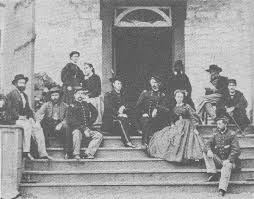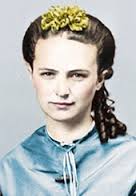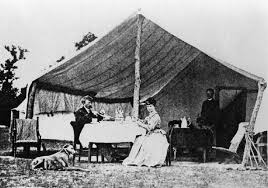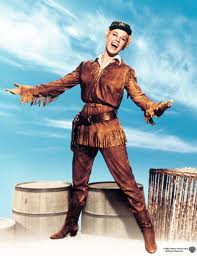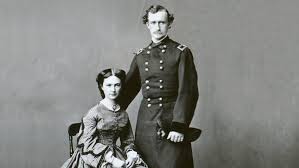1862 – William Sidney Porter is born in Greensboro, North Carolina. Later under the name of O. Henry he created “The Cisco Kid.”
Missing Elizabeth
Time to enter to win a copy of the book
None Wounded, None Missing, All Dead: The Story of Elizabeth Bacon Custer.
“Daughter, marrying into the army, you will be poor always; but I count it infinitely preferable to riches with inferior society.”
Judge Bacon to Elizabeth Custer – 1866
George Custer raced his stallion, Jack, at full speed over the limitless Alkali grass covered plateau miles away from the main entrance of Fort Riley, Kansas. The foam-flecked animal was inches behind Elizabeth and her fast horse, Custis Lee. Both riders urged their horses on to even greater speed; the cold wind biting at their smiling faces.
George steered his ride along the foot of a high hill. Abruptly reaching a steep decline, he brought his horse to a quick halt. Elizabeth, dressed in a black riding skirt, uniform jacket, and an Excelsior hat, and riding sidesaddle pulled further ahead of her husband. Quickly looking around, George turned Jack in the direction of a narrow trail through a flinty apron of rocks. He followed the crude path as it wound around the hill then suddenly dropped back down and came out the other side of the steep decline in front of Elizabeth. She waved playfully at him. The horses found their rhythm and broke into a smooth gallop. Elizabeth glanced over at George and giggled like a little girl. The two rode on towards a distant, tumbled pile of thunderheads, sooty black at their base and pure white as whipped cream where they towered against the dome of the sky.
They slowed their horses and stopped next to a cluster of rocks. George dismounted and helped Elizabeth down from her ride. Draping their arms around one another they stood quietly staring at the land stretched out before them. “The prairie was worth looking over,” Elizabeth noted in her memoirs, “because it changed like the sea.” “People thought of the deep-grass as brown, but in the spring it could look almost anything else,” she added, “purple, or gold, or red, or any kind of blue. 1 Often when cloud shadows crossed the long swells, the whole prairie stirred, and seemed to mold and flow, as if it breathed.” In late January 1867, the terrain the Custers admired was winter-defeated, lightless and without color.
George loosened the hold he had on Elizabeth and she noticed his expression changed subtly. As post commander he needed to return to his duties. The responsibilities of coordinating and training more than 960 enlisted men was daunting, but the 27 year old was committed to the task.
To learn more about Elizabeth Bacon Custer and her marriage to George Armstrong Custer read
None Wounded, None Missing, All Dead: The Story of Elizabeth Bacon Custer.
This Day…
Common Enemies
Time to enter to win a copy of the book
None Wounded, None Missing, All Dead: The Story of Elizabeth Bacon Custer.
“Few living women can ride a horse equal to her and but few better.”
George Custer’s thoughts about Elizabeth’s equestrian skills – 1866
A group of mounted Union officers rode onto the crest of a barren hill overlooking Fort Riley, Kansas. Major Frederick Benteen was in the lead, his eyes were sharp as eagles and he searched out the vast country ahead with exceeding care. The military outpost the soldiers were riding towards in January 1867 was established to protect settlers and railroad workers from Indian attacks. Benteen and his division were going to reinforce that protection. He led troops in the battle against Cheyenne leader Black Kettle and his braves on the Washita River (near Cheyenne, Oklahoma) after the Civil War had ended. That experience convinced Benteen that he would be a major asset in the military’s quest to keep order on the expanding western frontier. “I struck the first blow in the Indian Wars…” he reminded his peers.
In addition to his involvement at the start of the Indian wars, Benteen openly agreed with his superior officer, General Phil Sheridan, who had been named administrator over the Great Plains after the War Between the States, that the best way to defeat the Indian would be to attack them during the winter months. The Plains Indians depended heavily on their warrior ponies that thrived primarily in the spring and summer. The ponies could easily outrun an Army horse and didn’t need saddles and shoes to do their job. They required very little sustenance either – no grain at all, just clumps of grass and very little water when it was available. The warrior ponies could also stand for hours without moving or neighing, which allowed its riders to sneak up on prey (deer, buffalo, etc.) easily. Winter was particularly hard on the animals because the ground was frozen. Finding any grass to eat under several layers of ice and snow was difficult. The ponies were generally skin-and-bones. Conversely, Army horses were sturdy during the winter, having fed on wholesome rations of grain. Soldiers could ride in on and Indian village, attack, and ride off with no fear of being followed.
Although Benteen shared his executive officer’s plan for when to engage the Indians in battle and also proved his considerable soldiering skills and dedication to the Union cause, General Sheridan made George Custer commander of the cavalry at Fort Riley. Benteen like many others resented George. He was one of the youngest decorated heroes of the Civil War, had attended West Point and rode thoroughbreds. Rumor had it he was conceited as a result of the accolades he had received and that Elizabeth was just as haughty. She too was educated and had mingled with presidents, senators, and generals. Benteen had not attended college and had a disdain for West Point graduates. His horse was not a pedigree, he had not been involved in combat, and his wife was not socially connected. Benteen believed answering to George would be difficult and supporting his staff a daily struggle, but orders had been given.
To learn more about Elizabeth Bacon Custer and her marriage to George Armstrong Custer read None Wounded, None Missing, All Dead: The Story of Elizabeth Bacon Custer.
This Day…
The Newlyweds
Enter now for a chance to win a copy of the book
None Wounded, None Missing, All Dead: The Story of Elizabeth Bacon Custer.
“General Custer has elements of character which will develop…and, dear girl, some of that development rests with you.”
Elizabeth Custer’s friend Laura Noble about her relationship with George – January 1864
Elizabeth paraded proudly around a small table set with a pristinely polished silver tea service and silver dinnerware. The elegant tea service came from the men in George’s command, the 7th Michigan Cavalry. The dinnerware was a present from the 1st Vermont Cavalry. Both were not only generous wedding presents, but also a show of support for the boy General and his leadership skills.
Elizabeth adjusted a vase of wild flowers in the center of the plates and cups then stood back to admire the scene. Hanging over the table was large photograph of George, resplendent in a crisp uniform. Elizabeth smiled at the image the staring back at her. Eliza Brown, the Custer’s capable cook and maid, watched the delighted bride through a crack in the kitchen door continue to fuss with the items on the table in an effort to make everything as perfect as she could.
Outside the sturdy, two-story farm house in Culpepper County, Virginia near the small town of Stevensburg, where Elizabeth and her new husband made their home, a myriad of troops were hustling about. George rode into the winter encampment of the Union Army barking orders at his regiment to get to their bunks and prepare for the evening meal. Hundreds of soldiers rushed about doing the duties they were ordered. Many of the men that made up the crude post were young and eager, others were much more senior with gray hair and weathered faces. Elizabeth noted that George was an imposing figure among the troops, his uniform hung well on his tall frame. His saber and scabbard were strapped to his waist and held in place with a silk sash.
Before swinging easily out of his saddle George scanned the area beyond the prairie road leading to the campsite. In the near distance he could see numerous furrows of jet-black glistening sod and a lone farmer guiding a plow being pulled by a mule team over the soil. Smoke from a chimney on a house next to the field lifted lazy blue wreaths into the sky. George called out to one of his older officers and issued instructions Elizabeth could barely hear. She glided over to George’s side just as the soldier left to carry out his job. “Do they obey you?” she asked. “Yes,” George replied laughing, “and I shall reduce you to subjection sometime.” Elizabeth laughed out loud at the notion.
To learn more about Elizabeth Bacon Custer and her marriage to George Armstrong Custer read
None Wounded, None Missing, All Dead: The Story of Elizabeth Bacon Custer.
This Day…
Courting Elizabeth
Enter now for a chance to win a copy of the book
None Wounded, None Missing, All Dead: The Story of Elizabeth Bacon Custer.
“Oh, Wifey, Wifey! One of those mustached, gift-striped and button critters will get our Libby yet.”
Judge Daniel Bacon to wife, Rhoda about the many young soldiers calling on their daughter Elizabeth
A full moon hovered over South Monroe Street and beams of light from the gigantic orb filtered though a cluster of clouds. Twenty-two year old George Armstrong Custer stumbled through the scene helped along by a friend who steadied his walk and kept him from falling. Both men were dressed in the uniform of the 5th Cavalry and both had been drinking. George was drunk. It was late and apart from the two inebriated soldiers the street was deserted. It was the fall of 1861 and numerous leaves dropped off the massive trees lining the thoroughfare and drifted across the path the men followed.
George was making his way to his sister, Ann Reeds’s home where he had been staying while recovering from a slight illness contracted after the Battle of Bull Run. George had carried dispatches to the Union troops holding their position against the Confederate Army lined up along Bull Run Creek near a railroad center called Manassas Junction in Virginia. The battle ended when the Northern Army was ordered to fall back toward Washington. The retreat was marred by a downpour of rain that left George suffering with chills and fever. In a short time he was sent back to Monroe to recuperate, George’s condition improved and he ventured out to local taverns where his friends gathered.
Arm and arm with his school chum, an intoxicated George and his buddy staggered down the roadway, singing at the top of their lungs. The commotion woke his sister and she raced to the front window of her house, followed closely by her husband and children, to see who was disturbing the quiet, respectable neighborhood. George weaved back and froth over the stone street, laughing at his obvious lack of balance.
Judge Bacon, who had been standing on his porch smoking his pipe, noticed the pair of soldiers making their way toward the Reeds. He recognized George Custer’s tall, lanky frame and watched him wave goodbye to the friend who escorted him safely home. Disgusted by the behavior of a prominent military figure, the Judge marched back into his own house and closed the door hard behind him.
George was unaware that Judge Bacon had witnessed the scene. He also had no idea that Elizabeth was gazing out of her upstairs bedroom window at the same moment. At the time she wasn’t surprised at the sight, having seen other young men who’d had too much to drink, she consider his actions standard fair.
To learn more about Elizabeth Bacon Custer and her marriage to George Armstrong Custer read
None Wounded, None Missing, All Dead: The Story of Elizabeth Bacon Custer.
This Day…
General Custer’s Libbie
Enter now for a chance to win None Wounded, None Missing, All Dead:
The Story of Elizabeth Bacon Custer.
On June 27, 1876, Captain Frederick William Benteen spotted a cluster of white objects lying in a heap on a hill north of the Bighorn River in southern Montana. Benteen, a 42-year old career Army officer with a shock of white hair combed dramatically back over his long, bare forehead and harassed face, urged his horse slowly toward the knoll. A party of dutiful soldiers followed along behind him, their angry silence filled the air. As Captain Benteen inched his horse cautiously onto the site it became clear that the achromatic objects lying motionless in the tall grass were the remains of General George Custer* and his regiment. The flesh and bones of 210 members of the 7th Cavalry lay strewn over a mile of bloody ground. All of the bodies except for General Custer’s had been stripped naked and were mutilated.
Captain Benteen climbed down off his horse and made his way to General Custer’s body, stepping over dead soldiers pierced by arrows and lances in the process. George Custer’s ghostly frame was riddled with a number of injuries, not the least of which was a gunshot wound to the left flank and left temple. Benteen studied the bodies around him noticing that not only did the Indians in the fight leave George’s remains in tact, but left his socks on his feet. They had not scalped him either – his short, wavy hair was undisturbed.
“There he is, God damn him,” Benteen said coldly to members of his battalion now digging graves to bury the dead. “He’ll never fight anymore.” Benteen had known the popular boy General for more than ten years and he never liked him. He thought George was overly proud and impulsive. The Captain removed a piece of paper and the stub of a pencil from a pocket on his uniform, wrote George’s name on it, and nailed it to the wooden stake marking the spot where the General fell. “I went over the battlefield carefully with a view to determine how the fight was fought,” a distressed Benteen wrote in a report two days after the conflict. “I arrived at the conclusion I have right now – that it was a rout, a panic, till the last man was killed…. George himself was responsible for the Little Big Horn action, and it is an injustice to attribute the blame to anyone else.” Benteen had been in George’s command and ordered to reinforce his beleaguered troops at the Battle of Little Big Horn. For reasons that would be debated the rest of his life, Benteen did not come to George’s aide.
During the battle, Elizabeth Bacon Custer was only a few hundred miles away, in the Dakota Territory, waiting bravely for news of the expedition. The escalation of the Great Sioux War had brought the 7th Cavalry to the frontier, and where George went, Elizabeth followed.
One of the most charming and controversial soldiers the country ever produced, George Armstrong Custer and his equally delightful and charming bride, were devoted to one another and valued the time they spent together in the field and at their never-permanent homes at various Army post. Many times, Elizabeth lived in tents alongside members of the 7th Cavalry.
Over the twelve years the Custers were together, Elizabeth had lived history. She and George honeymooned in the war zones of the waning years of the Civil Way, and she witnessed the surrender of Robert E. Lee at Appomattox Courthouse and later was given the table at which the terms of surrender were signed. After the Civil War, when George’s regiment was sent to Texas to facilitate Reconstruction and then to the plains states as an “Indian Fighter” Elizabeth began her life on the frontier and experienced the most thrilling events of her life, an adventure that lasted until the memorable day when Custer and his troops made their immortal last stand against the Sioux Indians.
To learn more about Elizabeth Bacon Custer and her marriage to George Armstrong Custer read None Wounded, None Missing, All Dead:
The Story of Elizabeth Bacon Custer.

